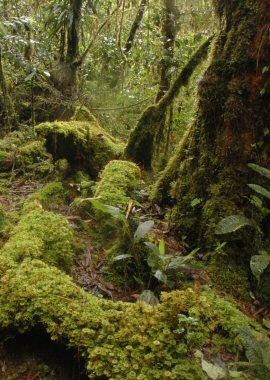2 August 2006
Pine Trees Not "Green"
by Kate Melville
 Landowners in the southern United States who are planting pine plantations may be contributing to rising carbon dioxide levels, says a study from Ohio State University. The researchers said that while planting trees is generally considered to be environmentally beneficial, pine plantations are in fact not that helpful. This is because pine plantations don't retain carbon as well as hardwood or natural pine forests, said study co-author Brent Sohngen. He added that, rather than pine, landowners should be looking at other tree types if they wanted to lower carbon dioxide levels.
Landowners in the southern United States who are planting pine plantations may be contributing to rising carbon dioxide levels, says a study from Ohio State University. The researchers said that while planting trees is generally considered to be environmentally beneficial, pine plantations are in fact not that helpful. This is because pine plantations don't retain carbon as well as hardwood or natural pine forests, said study co-author Brent Sohngen. He added that, rather than pine, landowners should be looking at other tree types if they wanted to lower carbon dioxide levels.
Sohngen's study, appearing in Ecological Economics, estimated that some 10 million acres (about the size of New Hampshire and Vermont) of mainly hardwood and natural pine forests will be chopped down to make way for pine plantations by 2030 in just three Southern states. That translates into roughly 700,000 tons more carbon dioxide released into the atmosphere annually, or 21 million tons over the 30-year period.
While 21 million tons may seem like a drop in the ocean compared to the 3 billion tons of carbon the U.S. emits annually, Sohngen is quick to point out that the model only included Arkansas, Louisiana and Mississippi; and that the results extrapolated to other states could mean that carbon dioxide emissions could be as much as four times higher. And the trend may be accelerating as it appears that pine plantation owners are now clearing more stands of hardwood trees and natural pines in order to cultivate plantations. Sohngen estimated that an area roughly the size of Los Angeles (about 333,600 acres) is converted to pine plantations each year.
Hardwood forests tend to store more carbon than pine plantations do because a hardwood forest has more organic matter - leaves, branches, roots, and a mix of tree species - than a pine plantation does, and more organic matter means more storage space for carbon. Natural pine stands, with a variety of plant and tree species growing in them, also have more organic matter than a carefully cultivated pine plantation.
Sohngen believes that owners of hardwood and natural pine forests should be encouraged to hold on to their stands, possibly with subsidies or carbon credits. Such subsidies would help close the gap between earnings from pine plantations and those from hardwood and natural pine stands. "Right now, landowners can make more money from pine than from hardwood stands," Sohngen said. "Historically, pine plantations are much more productive in terms of timber products. But maintaining hardwood and natural pine forests is an efficient way to store carbon. We can encourage landowners to hold on to these stands - and help reduce carbon dioxide in the atmosphere - by subsidizing their costs."
Source: Ohio State University
